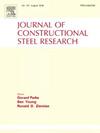Compressive behavior of square steel tube confined lightweight concrete with bamboo scrimber
IF 4
2区 工程技术
Q1 CONSTRUCTION & BUILDING TECHNOLOGY
引用次数: 0
Abstract
Bamboo scrimber, with its lightweight and high-strength properties, has emerged as one of the most promising green building materials. This study integrates bamboo scrimber into Steel Tube Confined Lightweight Aggregate Concrete (STCLAC) to form Square Steel Tube Confined Lightweight Aggregate Concrete Columns with Bamboo Scrimber (BSTCLAC), reducing structural deadweight and concrete usage. To comprehensively investigate the factors influencing the axial compression performance of these columns, key parameters were selected, including bamboo scrimber cross-section size, concrete strength, steel tube thickness, and the steel tube confinement type. A total of 15 specimens were fabricated and subjected to axial static load tests. The damage modes, displacement-load curves, load-strain curves, bearing capacity, and ductility were systematically analyzed. The test results revealed that under axial compression, the specimens primarily failed due to crushing at the structural joints of the steel tube. Bearing capacity increased initially but decreased as the cross-section size of the bamboo scrimber increased, with a maximum increase of 19.99 %. The increase in concrete strength led to a significant enhancement in bearing capacity, with a maximum increase of 37.01 %. Additionally, all BSTCLACs exhibited excellent ductility, with a maximum residual load capacity retention of 97.97 %. The inclusion of bamboo scrimber significantly boosted energy absorption and load-bearing performance under large deformations. Based on experimental data and unified strength theory, an axial compressive load capacity calculation model was proposed, demonstrating high accuracy with results closely matching experimental observations.
竹材具有轻质高强的特性,已成为最有前途的绿色建筑材料之一。本研究将竹节材融入钢管密实轻骨料混凝土(STCLAC)中,形成带竹节材的方形钢管密实轻骨料混凝土柱(BSTCLAC),从而减轻结构自重,减少混凝土用量。为了全面研究影响这些柱子轴向压缩性能的因素,我们选择了一些关键参数,包括竹蔑截面尺寸、混凝土强度、钢管厚度和钢管约束类型。共制作了 15 个试件,并对其进行了轴向静载试验。对破坏模式、位移-荷载曲线、荷载-应变曲线、承载能力和延性进行了系统分析。试验结果表明,在轴向压缩条件下,试样主要由于钢管结构连接处的挤压而失效。承载能力最初有所提高,但随着竹节护壁截面尺寸的增大而降低,最大增幅为 19.99%。混凝土强度的增加显著提高了承载能力,最大增幅为 37.01%。此外,所有 BSTCLAC 都表现出卓越的延展性,最大残余承载力保持率为 97.97%。在大变形情况下,竹材的加入大大提高了能量吸收和承载性能。在实验数据和统一强度理论的基础上,提出了轴向抗压承载力计算模型,该模型精确度高,计算结果与实验结果非常吻合。
本文章由计算机程序翻译,如有差异,请以英文原文为准。
求助全文
约1分钟内获得全文
求助全文
来源期刊

Journal of Constructional Steel Research
工程技术-工程:土木
CiteScore
7.90
自引率
19.50%
发文量
550
审稿时长
46 days
期刊介绍:
The Journal of Constructional Steel Research provides an international forum for the presentation and discussion of the latest developments in structural steel research and their applications. It is aimed not only at researchers but also at those likely to be most affected by research results, i.e. designers and fabricators. Original papers of a high standard dealing with all aspects of steel research including theoretical and experimental research on elements, assemblages, connection and material properties are considered for publication.
 求助内容:
求助内容: 应助结果提醒方式:
应助结果提醒方式:


